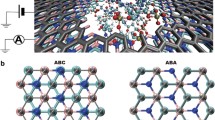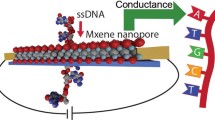Abstract
In this paper, we present a computational model to describe the electrical response of a constricted graphene nanoribbon (GNR) to biomolecules translocating through a nanopore. For this purpose, we use a self-consistent 3D Poisson equation solver coupled with an accurate three-orbital tight-binding model to assess the ability for a gate electrode to modulate both the carrier concentration as well as the conductance in the GNR. We also investigate the role of electrolytic screening on the sensitivity of the conductance to external charges and find that the gate electrode can either suppress or enhance the screening of biomolecular charges in the nanopore depending on the value of its potential. Translocating a double-stranded DNA molecule along the pore axis imparted a large change in the conductance at particular gate voltages, suggesting that such a device can be used to sense translocating biomolecules and can be actively tuned to maximize its sensitivity.





Similar content being viewed by others
References
Avdoshenko, S.M., Nozaki, D., Gomes da Rocha, C., González, J.W., Lee, M.H., Gutierrez, R., Cuniberti, G.: Dynamic and electronic transport properties of dna translocation through graphene nanopores. Nano Lett. 3(5), 1969–1976 (2013)
Baskin, A., Král, P.: Electronic structures of porous nanocarbons. Scientific reports 1 (2011).
Boykin, T.B., Luisier, M., Klimeck, G., Jiang, X., Kharche, N., Zhou, Y., Nayak, S.K.: Accurate six-band nearest-neighbor tight-binding model for the \(\pi \)-bands of bulk graphene and graphene nanoribbons. J. Appl. Phys. 109(10), 104304 (2011)
Branton, D., Deamer, D.W., Marziali, A., Bayley, H., Benner, S.A., Butler, T., Di Ventra, M., Garaj, S., Hibbs, A., Huang, X., et al.: The potential and challenges of nanopore sequencing. Nat. Biotechnol. 26(10), 1146–1153 (2008)
Brey, L., Fertig, H.: Electronic states of graphene nanoribbons studied with the dirac equation. Phys. Rev. B 73(23), 235411 (2006)
Cervantes-Sodi, F., Csanyi, G., Piscanec, S., Ferrari, A.: Edge-functionalized and substitutionally doped graphene nanoribbons: electronic and spin properties. Phys. Rev. B 77(16), 165427 (2008)
Datta, S.: Electronic Transport in Mesoscopic Systems. Cambridge University Press, Cambridge (1997)
Ezawa, M.: Peculiar width dependence of the electronic properties of carbon nanoribbons. Phys. Rev. B 73(4), 045432 (2006)
Garaj, S., Hubbard, W., Reina, A., Kong, J., Branton, D., Golovchenko, J.: Graphene as a subnanometre trans-electrode membrane. Nature 467(7312), 190–193 (2010)
Garaj, S., Liu, S., Golovchenko, J.A., Branton, D.: Molecule-hugging graphene nanopores. Proc. Natl. Acad. Sci. 110(30), 12192–12196 (2013)
Girdhar, A., Sathe, C., Schulten, K., Leburton, J.P.: Graphene quantum point contact transistor for dna sensing. Proc. Natl. Acad. Sci. 110(42), 16748–16753 (2013)
Gracheva, M.E., Aksimentiev, A., Leburton, J.P.: Electrical signatures of single-stranded dna with single base mutations in a nanopore capacitor. Nanotechnology 17(13), 3160 (2006)
Gracheva, M.E., Xiong, A., Aksimentiev, A., Schulten, K., Timp, G., Leburton, J.P.: Simulation of the electric response of dna translocation through a semiconductor nanopore-capacitor. Nanotechnology 17(3), 622 (2006)
Han, M.Y., Özyilmaz, B., Zhang, Y., Kim, P.: Energy band-gap engineering of graphene nanoribbons. Phys. Rev. Lett. 98(20), 206805 (2007)
Ho, C., Qiao, R., Heng, J.B., Chatterjee, A., Timp, R.J., Aluru, N.R., Timp, G.: Electrolytic transport through a synthetic nanometer-diameter pore. Proc. Natl. Acad. Sci. USA 102(30), 10445–10450 (2005)
Ivanov, A.P., Instuli, E., McGilvery, C.M., Baldwin, G., McComb, D.W., Albrecht, T., Edel, J.B.: DNA tunneling detector embedded in a nanopore. Nano Lett. 11(1), 279–285 (2010)
Konschuh, S., Gmitra, M., Fabian, J.: Tight-binding theory of the spin-orbit coupling in graphene. Phys. Rev. B 82(24), 245412 (2010).
Lagerqvist, J., Zwolak, M., Di Ventra, M.: Fast dna sequencing via transverse electronic transport. Nano Lett. 6(4), 779–782 (2006)
Merchant, C.A., Healy, K., Wanunu, M., Ray, V., Peterman, N., Bartel, J., Fischbein, M.D., Venta, K., Luo, Z., Johnson, A.C., et al.: Dna translocation through graphene nanopores. Nano Lett. 10(8), 2915–2921 (2010)
Meric, I., Han, M.Y., Young, A.F., Ozyilmaz, B., Kim, P., Shepard, K.L.: Current saturation in zero-bandgap, top-gated graphene field-effect transistors. Nature Nanotechnol. 3(11), 654–659 (2008)
Nelson, T., Zhang, B., Prezhdo, O.V.: Detection of nucleic acids with graphene nanopores: ab initio characterization of a novel sequencing device. Nano Lett. 10(9), 3237–3242 (2010)
Neto, A.C., Guinea, F., Peres, N., Novoselov, K.S., Geim, A.K.: The electronic properties of graphene. Rev. Modern Phys. 81(1), 109 (2009)
Nikolaev, A., Gracheva, M.E.: Simulation of ionic current through the nanopore in a double-layered semiconductor membrane. Nanotechnology 22(16), 165202 (2011)
Ntalikwa, J.W.: Determination of surface charge density of \(\alpha \)-alumina by acid-base titration. Bull. Chem. Soc. Ethiopia 21(1), 117–128 (2007)
Postma, H.W.C.: Rapid sequencing of individual dna molecules in graphene nanogaps. Nano Lett. 10(2), 420–425 (2010)
Ritter, K.A., Lyding, J.W.: The influence of edge structure on the electronic properties of graphene quantum dots and nanoribbons. Nat. Mater. 8(3), 235–242 (2009)
Saha, K.K., Drndić, M., Nikolic, B.K.: Dna base-specific modulation of microampere transverse edge currents through a metallic graphene nanoribbon with a nanopore. Nano Lett. 12(1), 50–55 (2011)
Sathe, C., Zou, X., Leburton, J.P., Schulten, K.: Computational investigation of dna detection using graphene nanopores. ACS Nano 5(11), 8842–8851 (2011)
Schadt, E.E., Turner, S., Kasarskis, A.: A window into third-generation sequencing. Hum. Mol. Genet. 19(R2), R227–R240 (2010)
Schneider, G.F., Kowalczyk, S.W., Calado, V.E., Pandraud, G., Zandbergen, H.W., Vandersypen, L.M., Dekker, C.: Dna translocation through graphene nanopores. Nano Lett. 10(8), 3163–3167 (2010)
Sint, K., Wang, B., Král, P.: Selective ion passage through functionalized graphene nanopores. J. Am. Chem. Soc. 130(49), 16448–16449 (2008)
Storm, A., Chen, J., Ling, X., Zandbergen, H., Dekker, C.: Fabrication of solid-state nanopores with single-nanometre precision. Nat. Mater. 2(8), 537–540 (2003)
Sverjensky, D.A.: Prediction of surface charge on oxides in salt solutions. Geochimica et Cosmochimica Acta 69(2), 225–257 (2005)
Wells, D.B., Belkin, M., Comer, J., Aksimentiev, A.: Assessing graphene nanopores for sequencing dna. Nano Lett. 12(8), 4117–4123 (2012)
Xie, P., Xiong, Q., Fang, Y., Qing, Q., Lieber, C.M.: Local electrical potential detection of dna by nanowire-nanopore sensors. Nat. Nanotechnol. 7(2), 119–125 (2012)
Acknowledgments
A.G. and J.-P.L. thank Oxford Nanopore Technology for their support. A.G. and C.S. would like to thank the Beckman Institute for their support through the Beckman Graduate Fellowship, as well as the Taub Campus Cluster for computational resources. This work was supported by National Institutes of Health (NIH) grant 9P41GM104601 and by the National Science Foundation (NSF) grant HPY0822613. This work used computer time on Stampede at the Texas Advanced Computing Center (TACC), provided by grant MCA93S028 from the Extreme Science and Engineering Discovery Environment (XSEDE), which is supported by National Science Foundation Grant number OCI-1053575
Author information
Authors and Affiliations
Corresponding author
Rights and permissions
About this article
Cite this article
Girdhar, A., Sathe, C., Schulten, K. et al. Gate-modulated graphene quantum point contact device for DNA sensing. J Comput Electron 13, 839–846 (2014). https://doi.org/10.1007/s10825-014-0596-6
Published:
Issue Date:
DOI: https://doi.org/10.1007/s10825-014-0596-6




